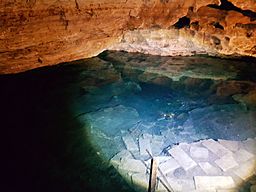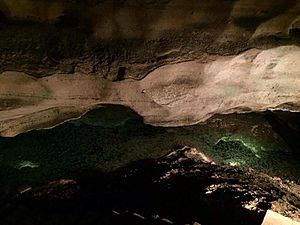Engelbrecht Cave facts for kids
Quick facts for kids Engelbrecht Cave |
|
|---|---|
| North Terrace Cave Vansittarts Cave 5L19 & 5L20 |
|
 |
|
| Location | Chute Street, Mount Gambier |
| Depth | 12 metres (39 ft) |
| Discovery | 1864 (by Europeans) |
| Geology | Limestone |
| Difficulty | Above water - no stated difficulty Underwater - CDAA Cave & Advanced Cave grades |
| Hazards | Sump (cave) |
| Access | Above water - public (no disabled access). Underwater - by permit. |
| Lighting | Yes |
| Visitors | Yes |
| Features | Yes |
| Website | http://www.engelbrechtcave.com/ |
Engelbrecht Cave is a cool cave system found right under the city of Mount Gambier in South Australia. It's also known by other names like North Terrace Cave or Vansittarts Cave. This cave is a type of sinkhole, which means it's a natural hole in the ground that leads into a cave.
The cave has two main tunnels or passages. One goes east, and the other goes west. The city of Mount Gambier owns the cave. They have made it a fun place for tourists to visit. You can explore the dry parts of the cave, which are like a special "show cave." But there are also parts of the cave filled with water. These are popular spots for cave diving, but only for experienced divers.
Contents
Exploring Engelbrecht Cave Passages
Engelbrecht Cave is located in a residential area of Mount Gambier. You can find it near Jubilee Highway West. The main entrance to the cave from the street is on Chute Street.
What the Cave Looks Like Inside
The cave starts with a large collapsed area, which is the sinkhole. From there, two main passages branch out.
- The east passage goes for about 70 meters (230 feet) from the entrance. It leads to a lake inside the cave. Beyond this lake, there's a water-filled tunnel that connects to an air chamber.
- The west passage is much longer, stretching about 300 meters (980 feet). Most of this passage is underwater and can only be explored by cave divers. It also has a large air chamber located directly under Jubilee Highway West.
The ground level outside the cave is about 41 meters (135 feet) above sea level. Inside the cave, the water level stays at about 12 meters (39 feet) above sea level.
Understanding the Cave's Names
The cave is named after Carl Engelbrecht. He was a German immigrant who lived in Mount Gambier in the 1800s. You might also hear it called Engelbrecht's Cave, North Terrace Cave, or Vansittarts Cave.
Names for Divers and Explorers
The Cave Divers Association of Australia (CDAA) gives special names to the underwater parts:
- The flooded part of the eastern passage is called Engelbrechts Cave - East.
- The flooded part of the western passage is called Engelbrechts Cave - West.
The Cave Exploration Group (South Australia) Incorporated (CEGSA) also has its own way of identifying the cave. They see it as two separate sites:
- The east-running passage is numbered 5L-19.
- The west-running passage is numbered 5L-20.
How the Cave Was Formed
Engelbrecht Cave is carved out of a type of rock called limestone. This specific limestone is known as Gambier Limestone. It formed a very long time ago, between 35 and 45 million years ago! At the cave's location, this limestone layer is about 100 meters (330 feet) thick.
The soil around the cave is special too. It came from volcanic eruptions. This soil dates back to the last time the Mount Gambier volcano erupted, which was between 2,800 and 26,000 years ago.
A Look Back at the Cave's History
People have known about Engelbrecht Cave for a long time.
Early Explorations
- The cave was first written about in 1865 by Julian Tenison-Woods. He was the first to use the name Vansittarts Cave.
- In 1864, four men reportedly explored the cave in a canoe. One of them, Charles Grosser, told his story to a local newspaper in 1933. He was only seven years old when he went on the adventure! He said the current was strong and carried them far into the cave. However, some records suggest his description might not perfectly match the cave we know today.
Carl Engelbrecht's Connection
In 1885, Carl Engelbrecht bought a flour mill nearby. He turned it into a whiskey distillery. He used the cave to get rid of waste from his distillery, like bottles and a caustic liquid called "slimper."
Becoming a Public Site
- In May 1929, the local government, the District Council of Mount Gambier, bought the land where the cave is.
- In 1940, the cave was sealed off after a council member checked it out.
- In 1964, the council looked for ideas to turn the cave into a tourist attraction. A team of four divers, including famous diver Dave Burchell, explored the cave. They found a muddy passage and a small lake. Their report said it wasn't suitable for tourism at that time.
- In 1979, the Lions Club of Mount Gambier started a project to make the cave beautiful. This work took three years and cost $10,000.
- In 1995, Engelbrecht Cave was added to the South Australian Heritage Register. This means it's an important historical site.
Engelbrecht Cave Today
Today, a private company manages Engelbrecht Cave for the City of Mount Gambier. It's a popular place for visitors!
What You Can Do There
- There's a café where you can grab a snack.
- A tour desk helps you plan your visit.
- You can walk down into the cave system.
- There are viewing platforms where you can see the lakes in both the east and west passages.
- The site has toilets and open areas for picnics.
- You can take guided tours of the dry parts of both cave passages.
Cave Diving Access
If you want to go cave diving, there are rules:
- To dive the eastern passage, you need a CDAA Cave grade.
- To dive the western passage, you need a CDAA Advanced Cave grade. These are special certifications for experienced divers.


